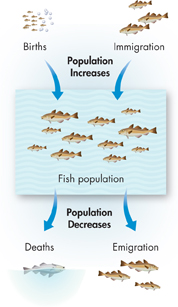Population Growth
 What factors affect population growth?
What factors affect population growth?
What determines whether a population grows, shrinks, or stays the same size? A population will increase or decrease in size depending on how many individuals are added to it or removed from it, as shown in Figure 5–3.  The factors that can affect population size are the birthrate, death rate, and the rate at which individuals enter or leave the population.
The factors that can affect population size are the birthrate, death rate, and the rate at which individuals enter or leave the population.
Birthrate and Death Rate Populations can grow if more individuals are born than die in any period of time. In other words, a population can grow when its birthrate is higher than its death rate. If the birthrate equals the death rate, the population may stay the same size. If the death rate is greater than the birthrate, the population is likely to shrink. Note that birth means different things in different species. Lions are born much like humans are born. Codfish, however, release eggs that hatch into new individuals.
Immigration and Emigration A population may grow if individuals move into its range from elsewhere, a process called immigration (im uh GRAY shun). Suppose, for example, that an oak grove in a forest produces a bumper crop of acorns one year. The squirrel population in that grove may increase as squirrels immigrate in search of food. On the other hand, a population may decrease in size if individuals move out of the population's range, a process called emigration (em uh GRAY shun). For example, a local food shortage or overcrowding can cause emigration. Young animals approaching maturity may emigrate from the area where they were born to find mates or establish new territories.

FIGURE 5–3 Natural Factors That Affect the Growth of a Fish Population The numbers of fish that hatch, die, enter, or leave the population affect the growth of the population. Use Models How would you expand this model to include the effects of fishing?
dExponential Growth
 What happens during exponential growth?
What happens during exponential growth?
If you provide a population with all the food and space it needs, protect it from predators and disease, and remove its waste products, the population will grow. Why? The population will increase because members of the population will be able to produce offspring. After a time, those offspring will produce their own offspring. Then, the offspring of those offspring will produce offspring. So, over time, the population will grow.
But notice that something interesting will happen: The size of each generation of offspring will be larger than the generation before it. This situation is called exponential (eks poh NEN shul) growth. In exponential growth, the larger a population gets, the faster it grows.  Under ideal conditions with unlimited resources, a population will grow exponentially. Let's examine why this happens under different situations.
Under ideal conditions with unlimited resources, a population will grow exponentially. Let's examine why this happens under different situations.
MYSTERY CLUE 
What kind of growth does the rabbit population in Australia exhibit? Why does that present a problem?
Table of Contents
- Formulas and Equations
- Applying Formulas and Equations
- Mean, Median, and Mode
- Estimation
- Using Measurements in Calculations
- Effects of Measurement Errors
- Accuracy
- Precision
- Comparing Accuracy and Precision
- Significant Figures
- Calculating With Significant Figures
- Scientific Notation
- Calculating With Scientific Notation
- Dimensional Analysis
- Applying Dimensional Analysis




